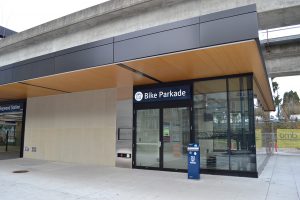Q&A: Bike Parkades support active transportation in Metro Vancouver
Q&A: Bike Parkades support active transportation in Metro Vancouver


Did you know 107,000 trips are made each day by cycling in Metro Vancouver?
As Metro Vancouver’s transportation authority, it’s our job to help support and grow the number of bike trips. How do we do this? We help provide connections to the wider transportation system of the region by making transit more bike-accessible.

That means including spaces on transit for bicycles, managing the Major Road Network (including five bridges), providing cycling options such as the BC Parkway, Central Valley Greenway and Canada Line Pedestrian–Bicycle Bridge, and developing the Regional Cycling Strategy.
We also invest in Bike Parkades—indoor facilities where registered customers can store their bikes for the day and connect directly to transit. The latest facility opened at Joyce–Collingwood Station just last month, joining the parkades at Main Street–Science World and King George stations.
Three more Bike Parkades will be opening this year at King Edward, Metrotown and Commercial–Broadway stations, with an additional seven in the years ahead.

Since these are relatively new to Metro Vancouver, I decided to get the scoop on Bike Parkades from Derek Yau, a transportation engineer with TransLink’s facility development and planning team!
What are Bike Parkades and how do they work?
Bike Parkades are secure facilities where customers who ride bikes to or from transit can lock their bike for the day. The parkade can be accessed with a registered Compass Card 24 hours a day, 7 days a week, for the very reasonable cost of $1 per use (per day) to a maximum of $8 per calendar month.
What’s the goal of Bike Parkades?
Simply put, it’s all about making cycling an attractive option for more people. The lack of traffic-separated bike infrastructure is a barrier to everyday cycling, but so is the lack of secure places to park your bike. That’s why in addition to investing in cycling routes, we also provide secure bicycle parking—in the form of Bike Parkades and lockers—at transit hubs throughout the region where we can.
We hope that by providing a safe, convenient, and affordable place to store your bike for the day, we can encourage more multi-modal trips and more everyday cycling within the region.
I think Bike Parkades help solve the first and last mile problem—the gap between transit to the final destination and vice versa. Do you agree?
Absolutely, Bike Parkades means a customer can ride their bike from their home to the SkyTrain station, securely park it, and continue their journey on transit to their final destination. Creating attractive and viable alternative options for getting to transit creates more capacity for others on our roads and buses. This is why it’s important for TransLink to invest in low-stress bicycle routes and secure bicycle parking.
It sounds like Bike Parkades and other cycling infrastructure is also all about providing commuters with options.
That’s correct. When options are provided, it supports and encourages a more efficient use of a limited resource: our shared public infrastructure. More people integrating walking and cycling into the daily transportation mix likely means fewer cars on the road, and more capacity on buses and trains!
To that end, what is TransLink doing to encourage active transportation aside from investing in Bike Parkades?
Through our municipal cost-sharing programs, TransLink contributes funding towards a variety of road, cycling and pedestrian improvement projects across Metro Vancouver, in addition to Major Road Network funding. In 2017, we helped fund 51 projects across 18 municipalities, totalling $23 million as part of the 10-Year Vision. Continued improvements to major roads, cycling, walking paths, and transit access points are planned in the next phase of 10-Year Vision funding.
Thanks for your time Derek! Are you ready to use a Bike Parkade? Watch this video:
Author: Allen Tung





